Compound Chocolate Market Size
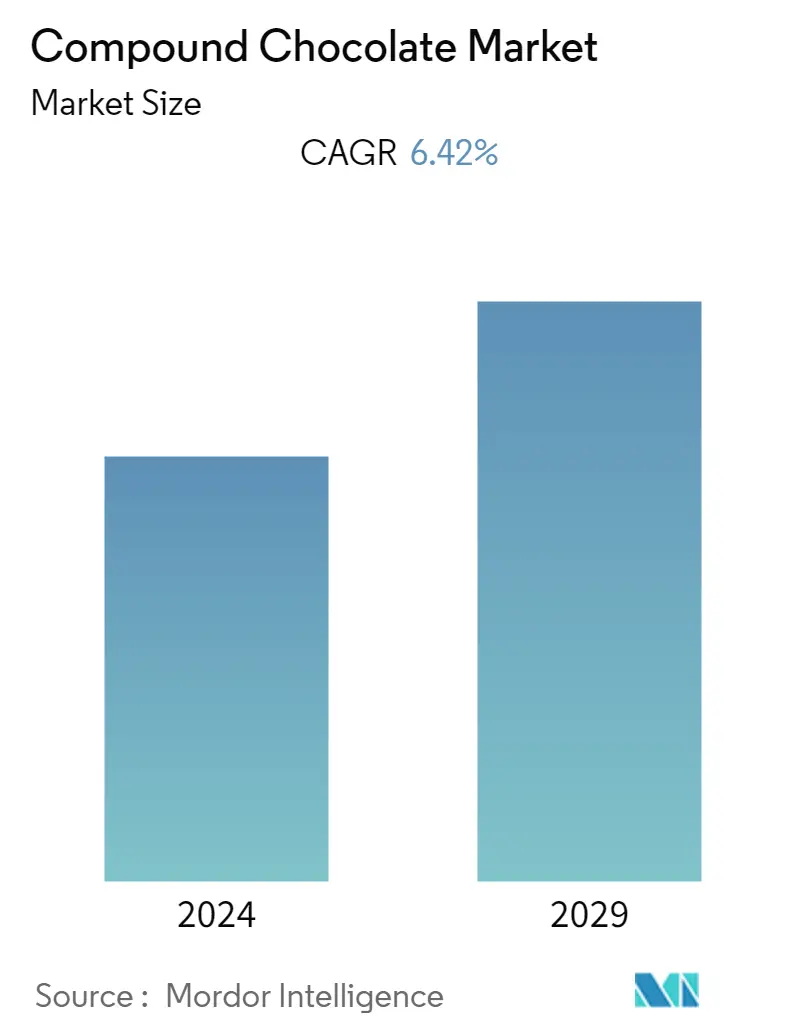
| Study Period | 2019 - 2029 |
| Base Year For Estimation | 2023 |
| CAGR | 6.42 % |
| Fastest Growing Market | Asia Pacific |
| Largest Market | Europe |
| Market Concentration | Low |
Major Players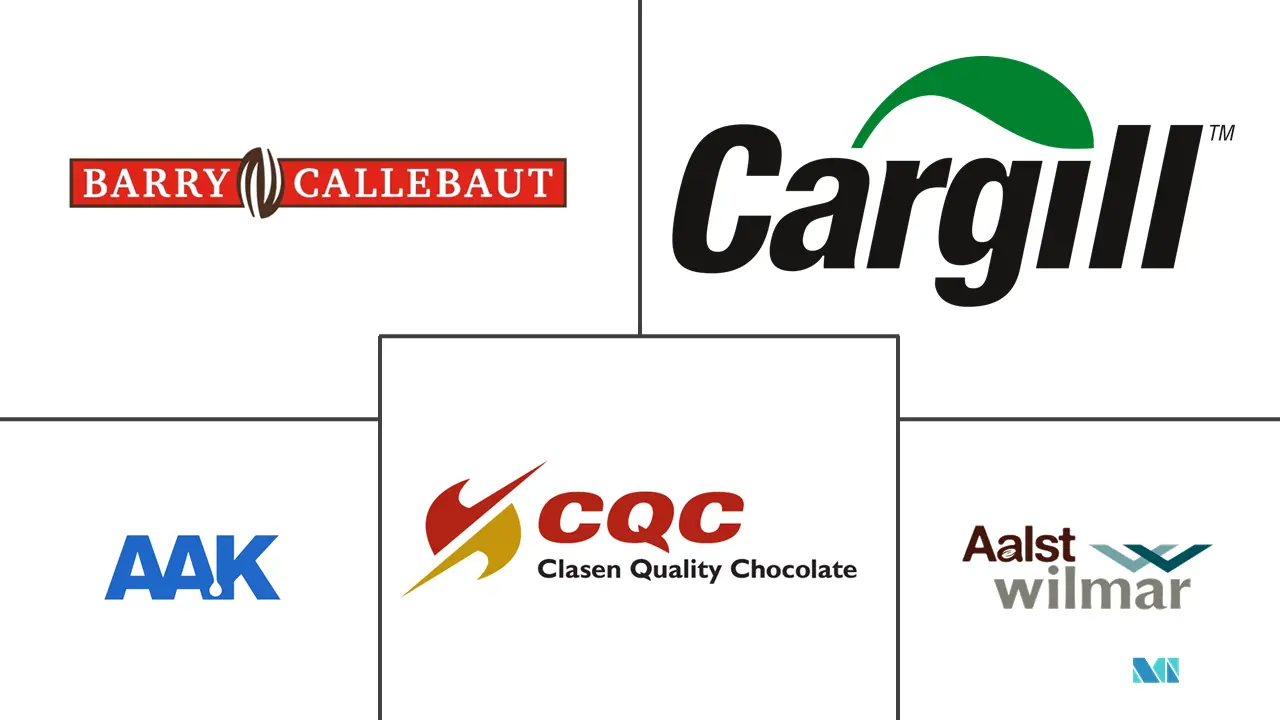
*Disclaimer: Major Players sorted in no particular order |
Compound Chocolate Market Analysis
The compound chocolate market is expected to register a CAGR of 6.42% during the forecast period (2022-2027).
The COVID-19 outbreak and supply-side issues linked to quality and certification impacted the chocolate market's sales. With the impact of COVID-19, mainstream consumption of compound chocolate at the retail and industrial levels seemed stable. However, the craft chocolate segment is facing difficulties. The market is observing demand for healthy ingredients, which opens an opportunity for better-for-you chocolates at the retail and application levels.
A primary factor driving the market for compound chocolate is its functionality at a lower price, which is boosting its demand. Its functional attributes allow it to be converted as a replica of coverture or real chocolate at a lower price than coverture chocolate.
Moreover, compound chocolate contains hard fat, making it suitable for products such as granola bars and trail mixes, where baking at higher temperatures is required. The composition of compound chocolate also helps increase the product's shelf life. Companies are coming up with sustainable solutions for sourcing and the usage of cocoa butter substitutes or cocoa butter equivalents in products.
Compound Chocolate Market Trends
This section covers the major market trends shaping the Compound Chocolate Market according to our research experts:
Increasing Demand for Single-origin and Certified Chocolate
The demand for fine flavor cocoa in Europe and North America is experiencing substantial growth. Ultra and high-end beans are being used for gourmet chocolates. Regular, low fine beans are being used for regular premium chocolates, especially in countries like the United Kingdom, the United States, China, India, the Netherlands, Germany, and Switzerland. This development is driven by the health trend and the need for more exclusive products. The premium cocoa market with sustainability and single-origin certification is boosting the market's overall growth. Manufacturers are introducing single-origin and premium chocolate line-ups in response to the propelling demand. They are also supporting the local economies. These strategies are helping brands gain more profit margins and grow with a more positive brand image. For instance, Nestle set up a new chocolate molding and packing line in Ecuador, which helped the company incorporate the single-origin specific variety "Arriba cocoa" beans to manufacture value-added chocolates for export and domestic consumption.
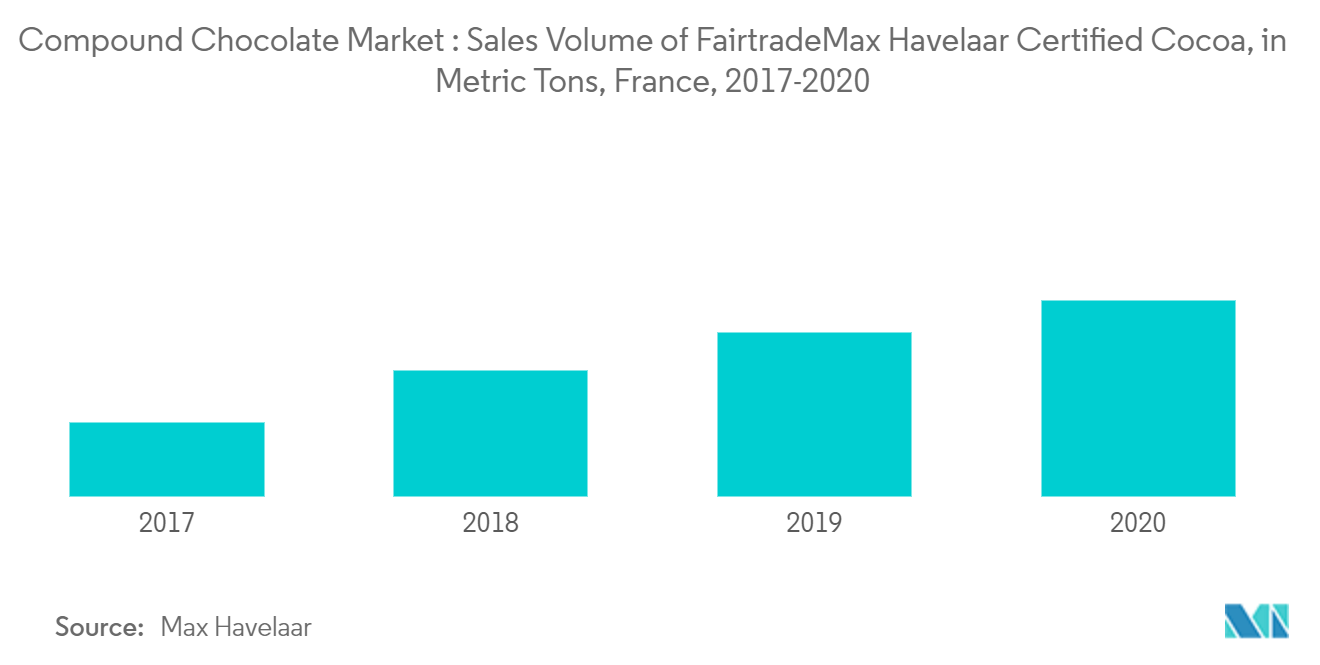
North America Holds the Largest Market Share
The demand for compound chocolate in North America is expected to grow, supported by the increasing demand for premium chocolate and confectionery items. Greater interest in healthy lifestyles continues to drive the consumption of sugar-free, organic, and dark chocolate. Properties of compound chocolate, such as its attractive price compared to pure cocoa-based chocolates and the ability to harden without tempering, make it an ideal choice for food manufacturers in various segments, such as bakery, confectionery, ice creams, and frozen desserts. Milk chocolate holds a major share in the North American compound chocolate market and continues to register demand, along with other flavors. Companies are coming up with sustainable solutions for sourcing and the usage of cocoa butter substitutes or cocoa butter equivalents for confectionery products.
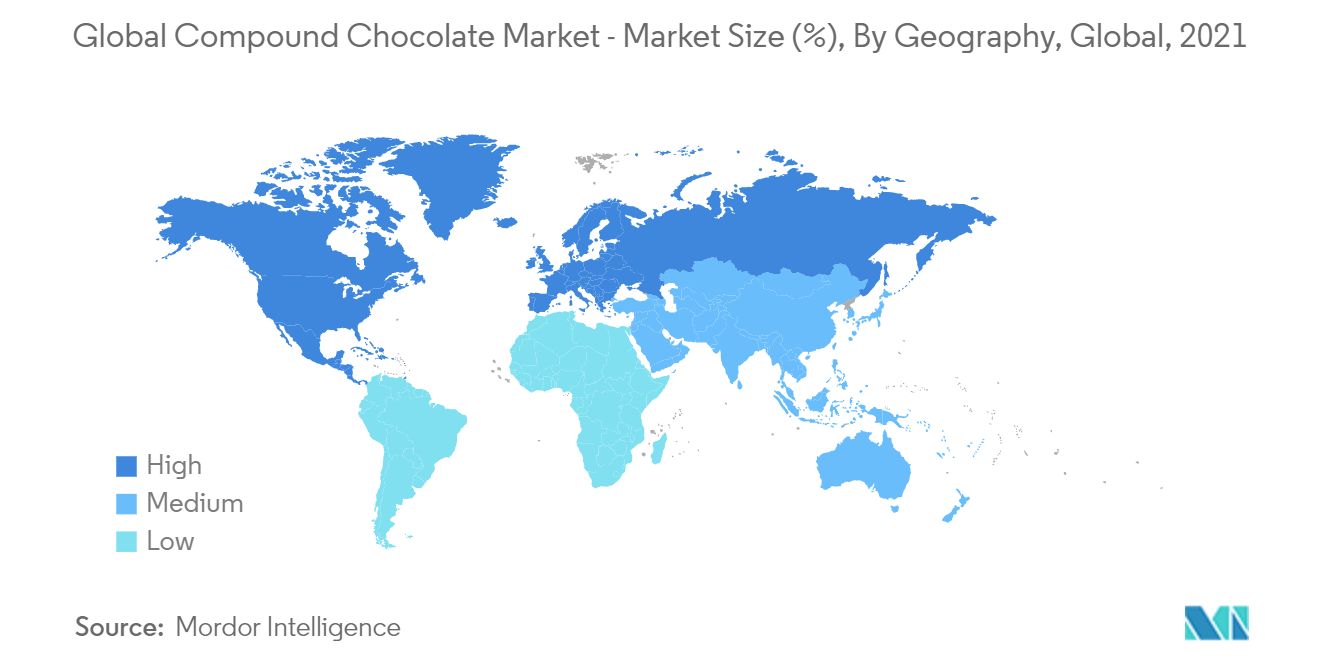
Compound Chocolate Industry Overview
The compound chocolate market is fragmented with the presence of various players. Manufacturers are coming up with several innovations in health aspects, with better cocoa butter substitutes (CBS) and cocoa butter equivalent (CBE). Major players in the compound chocolate market are Cargill Incorporated, AAK, Barry Callebaut, and Clasen Quality Chocolate Inc. As the manufacturing methods and flavors of compound chocolates improve, the cost differential in comparison to chocolate is likely to make chocolate compounds a more desirable choice. These companies have set their focus on R&D, aiming to retain their positions in the market or gain a competitive advantage. Furthermore, manufacturers in the market are focusing on special occasions such as Valentine's Day, Easter, and Christmas in different colors and shapes, matching the theme of the celebration.
Compound Chocolate Market Leaders
-
Barry Callebaut
-
Aalst Wilmar Pte Ltd
-
AAK
-
Cargill Incorporated
-
Clasen Quality Coatings Inc.
*Disclaimer: Major Players sorted in no particular order
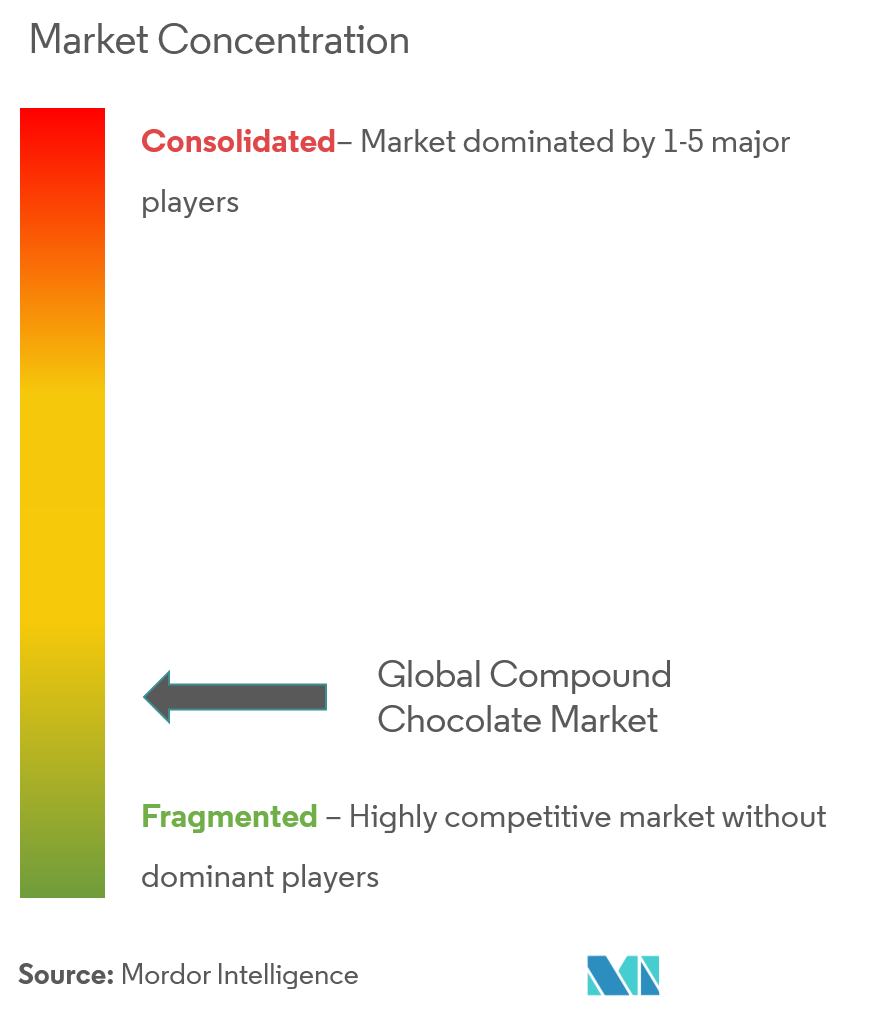
Compound Chocolate Market News
In January 2022, Mondelez International launched Oreo frozen desserts. The new line will include Oreo bars, cones, sandwiches, and tubs. The bars and cones contain Oreo pieces and are dipped in a coating made from crushed Oreo wafer pieces. The sandwiches feature two large Oreo wafers. All of the products feature a creme-flavored base with Oreo cookie pieces.
In December 2021, Lacta partnered with Froneri and launched an ice cream with a creamy filling and chocolate chips. The new product line is available in three flavors - Diamante Negro, Milk chocolate bonbon, and Laka Oreo.
In November 2021, Barry Callebaut launched a complete portfolio of the dairy-free chocolate compound, expanding its plant-based options. These new options are 100% plant-based. The new line includes dairy-free EZ melt compound, Compound Chip/Chunk, Compound Soft Chunk, Compound Soft Shaped Chunks, and Bulk Liquid for different applications.
Compound Chocolate Market Report - Table of Contents
1. INTRODUCTION
- 1.1 Study Assumptions and Market Definition
- 1.2 Scope of the Study
2. RESEARCH METHODOLOGY
3. EXECUTIVE SUMMARY
4. MARKET DYNAMICS
- 4.1 Market Drivers
- 4.2 Market Restraints
-
4.3 Porter's Five Forces Analysis
- 4.3.1 Threat of New Entrants
- 4.3.2 Bargaining Power of Buyers/Consumers
- 4.3.3 Bargaining Power of Suppliers
- 4.3.4 Threat of Substitute Products
- 4.3.5 Intensity of Competitive Rivalry
5. MARKET SEGMENTATION
-
5.1 By Type
- 5.1.1 Dark
- 5.1.2 Milk
- 5.1.3 White
-
5.2 By Form
- 5.2.1 Chocolate Chips/Drops/Chunks
- 5.2.2 Chocolate Slab
- 5.2.3 Chocolate Coatings
- 5.2.4 Other Forms
-
5.3 By Application
- 5.3.1 Bakery
- 5.3.2 Confectionery
- 5.3.3 Frozen Desserts and Ice Cream
- 5.3.4 Beverages
- 5.3.5 Cereals
- 5.3.6 Other Applications
-
5.4 By Geography
- 5.4.1 North America
- 5.4.1.1 United States
- 5.4.1.2 Canada
- 5.4.1.3 Mexico
- 5.4.1.4 Rest of North America
- 5.4.2 Europe
- 5.4.2.1 Spain
- 5.4.2.2 United Kingdom
- 5.4.2.3 Germany
- 5.4.2.4 France
- 5.4.2.5 Italy
- 5.4.2.6 Russia
- 5.4.2.7 Rest of Europe
- 5.4.3 Asia-Pacific
- 5.4.3.1 China
- 5.4.3.2 Japan
- 5.4.3.3 India
- 5.4.3.4 Australia
- 5.4.3.5 Rest of Asia-Pacific
- 5.4.4 South America
- 5.4.4.1 Brazil
- 5.4.4.2 Argentina
- 5.4.4.3 Rest of South America
- 5.4.5 Middle-East and Africa
- 5.4.5.1 South Africa
- 5.4.5.2 United Arab Emirates
- 5.4.5.3 Rest of Middle-East and Africa
6. COMPETITIVE LANDSCAPE
- 6.1 Most Active Companies
- 6.2 Most Adopted Strategies
- 6.3 Market Share Analysis
-
6.4 Company Profiles
- 6.4.1 Cargill Incorporated
- 6.4.2 Clasen Quality Chocolate Inc.
- 6.4.3 AAK
- 6.4.4 Barry Callebaut
- 6.4.5 Aalst Wilmar Pte Ltd
- 6.4.6 Sephra
- 6.4.7 Fuji Oil Holdings Inc
- 6.4.8 Puratos Group
- 6.4.9 Mondelez International
- 6.4.10 Ferrero International SA
- 6.4.11 Meiji Holdings Co. Ltd
- *List Not Exhaustive
7. MARKET OPPORTUNITIES AND FUTURE TRENDS
8. IMPACT OF COVID-19 ON THE MARKET
** Subject To AvailablityCompound Chocolate Industry Segmentation
Compound chocolates are cocoa products containing cocoa butter substitutes (CBS) or cocoa butter equivalent (CBE). The vegetable fats commonly used are often hard fats or semi-solid fats at room temperatures, such as coconut oil and palm kernel oil. The compound chocolate market is segmented into type, form, application, and geography. The report offers the market size and forecast in value (USD million) for all the above segments.
| By Type | Dark | |
| Milk | ||
| White | ||
| By Form | Chocolate Chips/Drops/Chunks | |
| Chocolate Slab | ||
| Chocolate Coatings | ||
| Other Forms | ||
| By Application | Bakery | |
| Confectionery | ||
| Frozen Desserts and Ice Cream | ||
| Beverages | ||
| Cereals | ||
| Other Applications | ||
| By Geography | North America | United States |
| Canada | ||
| Mexico | ||
| Rest of North America | ||
| By Geography | Europe | Spain |
| United Kingdom | ||
| Germany | ||
| France | ||
| Italy | ||
| Russia | ||
| Rest of Europe | ||
| By Geography | Asia-Pacific | China |
| Japan | ||
| India | ||
| Australia | ||
| Rest of Asia-Pacific | ||
| By Geography | South America | Brazil |
| Argentina | ||
| Rest of South America | ||
| By Geography | Middle-East and Africa | South Africa |
| United Arab Emirates | ||
| Rest of Middle-East and Africa |
Compound Chocolate Market Research FAQs
What is the current Compound Chocolate Market size?
The Compound Chocolate Market is projected to register a CAGR of 6.42% during the forecast period (2024-2029)
Who are the key players in Compound Chocolate Market?
Barry Callebaut, Aalst Wilmar Pte Ltd, AAK, Cargill Incorporated and Clasen Quality Coatings Inc. are the major companies operating in the Compound Chocolate Market.
Which is the fastest growing region in Compound Chocolate Market?
Asia Pacific is estimated to grow at the highest CAGR over the forecast period (2024-2029).
Which region has the biggest share in Compound Chocolate Market?
In 2024, the Europe accounts for the largest market share in Compound Chocolate Market.
What years does this Compound Chocolate Market cover?
The report covers the Compound Chocolate Market historical market size for years: 2019, 2020, 2021, 2022 and 2023. The report also forecasts the Compound Chocolate Market size for years: 2024, 2025, 2026, 2027, 2028 and 2029.
Compound Chocolate Industry Report
Statistics for the 2024 Compound Chocolate market share, size and revenue growth rate, created by Mordor Intelligence™ Industry Reports. Compound Chocolate analysis includes a market forecast outlook to 2029 and historical overview. Get a sample of this industry analysis as a free report PDF download.



